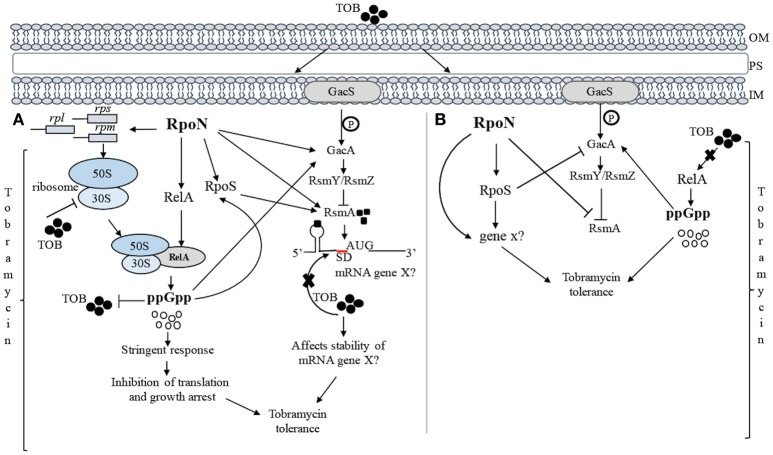Figure 6.
Proposed model for the involvement of RpoN in the regulation of tobramycin tolerance in the stationary growth (A) and logarithmic phase growth (B) in nutrient-rich medium. (A) RpoN stimulates the expression of the genes involved in the translation apparatus and positively affects the synthesis of ribosome components. Upon exposure to tobramycin, RpoN counteracts the negative effects of tobramycin on translation by increasing the expression of relA, which in turn produces the effector of the stringent response, ppGpp. ppGpp promotes survival in the presence of tobramycin by inducing translational inactivity and affecting the growth rate. The translational inactivity produced by ppGpp blocks tobramycin from exerting its effect on the ribosome and consequently leads to tobramycin tolerance. In addition, RpoN positively affects the expression of rpoS in the presence of tobramycin and employs RsmA to overcome the effect of tobramycin, likely by increasing the mRNA stability of a gene potentially involved in tobramycin tolerance. RpoN increases the expression of gacA in response to tobramycin, which probably occurs through a ppGpp-dependent pathway. (B) During the logarithmic phase of growth, RpoN employs the RpoS-dependent pathway, which in turn activates additional stress-response genes promoting the survival to tobramycin. RpoN profoundly downregulates the expression of rsmA in response to tobramycin. Furthermore, RpoS negatively affects the expression of gacA in the presence of tobramycin. The mutant deficient in rpoN and rpoS demonstrates (i) the loss of tobramycin-mediated inhibition of relA expression, (ii) a consequent increase in ppGpp production, and (iii) suggests ppGpp-dependent upregulation of gacA, which together lead to tobramycin tolerance. The detailed regulation network is described in the Discussion. OM, outer membrane; PS, periplasmic space; IM, inner membrane; TOB, tobramycin; → represents positive control; ⊥ represents negative control.

